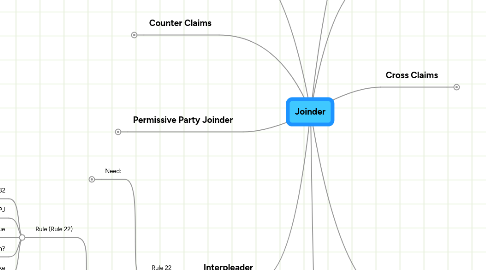
1. Simple PL Joinder
1.1. Rule 18
1.1.1. ANY Claim PL has against DF
1.1.2. Major limitation
1.1.2.1. SMJ test
1.1.2.1.1. Common nucleus of operative facts
2. Counter Claims
2.1. Rule 13
2.1.1. Compulsory
2.1.1.1. Rule 13(b)
2.1.1.2. ST&O
2.1.1.3. Logical Relationship Test
2.1.1.4. SMJ
2.1.1.4.1. Will exist if needed
2.1.1.4.2. See if it will stand on its own first
2.1.2. Permissive
2.1.2.1. Rule 13(a)
2.1.2.2. Everything that is not Compulsory
2.1.2.3. SMJ
2.1.2.3.1. Must stand on its own
2.1.2.4. A counter claim CANNOT create FQ
3. Cross Claims
3.1. Rule 13(g)
3.1.1. Between DF1 and DF2
3.1.2. Must meet requirements
3.1.2.1. ST&O as anchor
3.1.2.2. As determined by the same core of operative facts
3.1.3. SMJ
3.1.3.1. Will exist if needed
3.1.4. ALWAYS permissive
4. Permissive Party Joinder
4.1. Rule 20
4.1.1. PL can bring them if they want to
4.1.2. Claims must arise from ST&O or series of ST&O's
4.1.2.1. Two views
4.1.2.1.1. Narrow
4.1.2.1.2. Broad
4.1.3. And, must share common question of law and fact
5. Impleader (TPP)
5.1. Rule 14
5.1.1. DF has opportunity to bring in third party DF
5.1.2. MUST be for derivative liability
5.1.3. What do you have to do?
5.1.3.1. Implead
5.1.3.1.1. Serve with summons and complaint
5.1.3.2. All timelines apply
5.1.3.3. Only have to make motion for leave of the court if wait 10 days after filing answer
5.1.3.4. SMJ
5.1.3.4.1. No problem if filed properly
5.1.3.5. PJ
5.1.3.5.1. Still must go thru PJ
5.1.4. What can TP DF do?
5.1.4.1. All joinder rules
5.1.4.2. Can assert any defenses DF has against PL
5.1.4.2.1. To break chain of liability
6. 100 Mile Bulge
6.1. Rule 4(k)(1)(b)
6.1.1. ONLY in Rule 14 or 19
6.1.2. If they are within 100 miles of court house, you can get PJ
7. Compulsory Party Joinder
7.1. Rule 19
7.1.1. Follows a 12(b)(7) motion to dismiss for failure to join a necessary party
7.1.2. MUST bring in new DF, if feasible
7.1.3. Analysis
7.1.3.1. 19(a) Are they a necessary party?
7.1.3.1.1. 19(a)(1)(A) In the absence of the party, complete relief cannot be afforded
7.1.3.1.2. 19(a)(1)(B) Absentee claims an interest in subject matter so substantial...
7.1.3.2. Can they be joined
7.1.3.2.1. Yes - Join them Rule 19(a)(2)
7.1.3.2.2. No, goto 19(b)
7.1.3.3. 19(b) Are they indispensible?
7.1.3.3.1. "In equity and good conscience," can the suit go forward
8. Intervention
8.1. Rule 24(a)
8.1.1. Of right
8.1.2. MUST
8.1.3. Raised on a timely motion
8.1.3.1. Timely motion
8.1.3.1.1. Court's discretion what is timely
8.1.3.2. Proposed pleading
8.1.3.2.1. Grounds:
8.1.4. SUMMARY - 5 Questions
8.1.4.1. Is the motion timely
8.1.4.1.1. If the jury's out, shitcanned
8.1.4.2. Do they have an unconditional right
8.1.4.2.1. Rare
8.1.4.2.2. Federal statute
8.1.4.3. Do they have an interest relating to the subject matter of the suit
8.1.4.4. As a practical matter, is their interest impeded
8.1.4.5. Are they already represented
8.2. Rule 24(b)
8.2.1. Permissive
8.2.2. Completely at court's discretion
8.2.3. MAY
9. Interpleader
9.1. Rule 22
9.1.1. Need:
9.1.1.1. A stake
9.1.1.2. Stakeholder
9.1.1.3. Potential for double or multiple liability
9.1.1.3.1. To or more adverse claimants to the stake
9.1.2. 2 kinds
9.1.2.1. Rule (Rule 22)
9.1.2.1.1. S1332
9.1.2.1.2. PJ
9.1.2.1.3. Venue
9.1.2.1.4. Injunction?
9.1.2.1.5. Deposit of the stake
9.1.2.2. Statutory
9.1.2.2.1. S1335
9.1.2.2.2. PJ
9.1.2.2.3. Venue
9.1.2.2.4. Injunction?
9.1.2.2.5. Deposit of the stake
